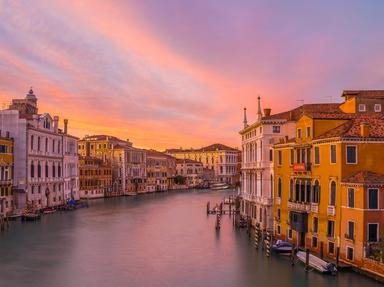Quiz Answer Key and Fun Facts
1. As we leave the hubbub of Florence behind we travel through one of the most underrated areas of Italy, that of Umbria and its magnificent hill towns. In Orvieto we admire the cathedral in its alternating layers of black and white stone, and the golden face of the cathedral ablaze in the reflected light of the setting sun. We tour a museum of artifacts from a mysterious pre-Roman civilization, whose tombs and other edifices dot the Umbrian landscape. What were these people called?
2. We pass through Perugia and Deruta, famous for its handpainted pottery, particularly of the designs from the civilization in question #1, and reach Assisi, the rival power of Perugia during the Renaissance. We come to a church built in three levels. What famous animal-loving saint is buried in the plain stone tomb of the lowest church?
3. We leave the church and return to the car, finding every car in our vicinity with a ticket. We see no "no parking" signs and figure it was a mistake, so we toss the ticket and move on. As we approach Rome, we meet friends at the outskirts, who lead us through the traffic to our hotel. That evening, our friends take us to the fashionable "authentically Roman" section of Rome, dotted with cafes, restaurants, and trendy shops. The name of the quarter means "across the Tiber". Where are we?
4. The next day we sightsee Rome in earnest. We enter a large square with a church, three fountains, and artists selling their wares. The largest central fountain is replete with figures and waterfalls representing four great rivers of the world. I also hear this large open space is used for track races, and is built above an ancient stadium. What is the name of this area?
5. At Vatican City, the smallest nation in the world at 106 acres, we find all of the following except which?
6. We tour the Vatican museums and the Sistine Chapel, and the papal apartments of Julius II. We see the famous "School of Athens" painted on the wall. This famous artist, buried in the Pantheon, took 16 years on the project and died before it was finished. Who decorated the papal apartments?
7. On the outskirts of Rome, we see the remains of an old Roman road, dotted with old Roman tombs and aqueducts. What is the name of this road?
8. Everyone who goes to Rome must pass through the Roman forum. As we peruse the ruins, we look upon the hill where the rulers of Rome built their palaces,and the homes of of Augustus, Livia, Flavia, and Septimus Severus. What is the name of this hill?
9. Leaving Rome we head to Naples and the nearby ruins of Pompeii, in the shadow of Mount Vesuvius. In 79 A.D. Pompeii was buried in 20 feet of ash and pumice. What is the name of the lesser known city buried by mud in this eruption? It is named after an ancient hero.
10. South of Naples we drive along the famous picturesque stretch of coast along the Sorrento peninsula, with the road winding high above the water, and including towns such as Positano, Ravello, and Sorrento. What is this area called?
Source: Author
jstagamtome
This quiz was reviewed by FunTrivia editor
minch before going online.
Any errors found in FunTrivia content are routinely corrected through our feedback system.

